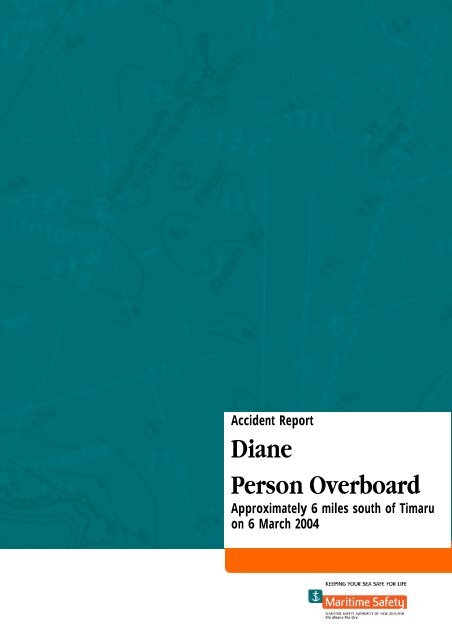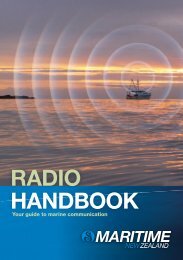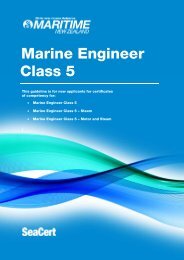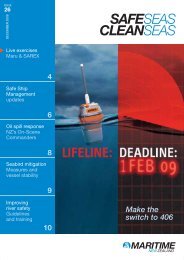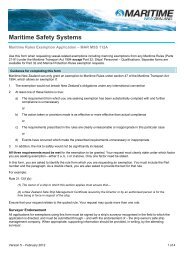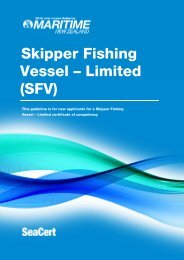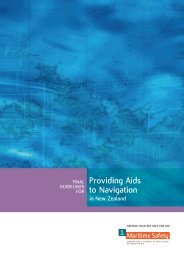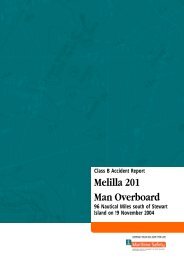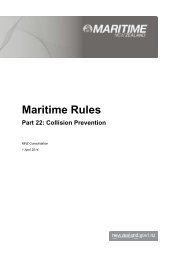Accident Investigation Report Commerial Fishing Diane Timaru ...
Accident Investigation Report Commerial Fishing Diane Timaru ...
Accident Investigation Report Commerial Fishing Diane Timaru ...
Create successful ePaper yourself
Turn your PDF publications into a flip-book with our unique Google optimized e-Paper software.
<strong>Accident</strong> <strong>Report</strong><strong>Diane</strong>Person OverboardApproximately 6 miles south of <strong>Timaru</strong>on 6 March 2004
REPORT NO: 04 3461VESSEL NAME:DIANECASUALTY DETAILS:Date of Casualty: 6 March 2004Time of Casualty:Casualty Type:Casualty Location:Weather Forecast Area:1600 hours New Zealand Daylight Time (NZDT)Person OverboardApproximately 6 miles south of <strong>Timaru</strong>RangitataDate MSA Notified: 8 March 2004Date <strong>Investigation</strong> Started: 8 March 2004Date <strong>Investigation</strong> Completed: 5 November 2004Investigator:John WhiteleyMaritime Safety Authority <strong>Accident</strong> <strong>Investigation</strong> <strong>Report</strong>2
REPORT NO: 04 3461VESSEL NAME:DIANEVESSEL DETAILS:Ship Name:Ship Category:Certified Operating Limit:<strong>Diane</strong><strong>Fishing</strong>InshoreRegistered Length (m): 11.61Gross Tonnage: 16.85Flag:New ZealandMaritime Safety Authority <strong>Accident</strong> <strong>Investigation</strong> <strong>Report</strong>3
SUMMARYOn 6 March 2004, <strong>Diane</strong> was found idling with the engine in neutral and a fishingnet still in the water over the stern. There was no sign of the Skipper who ismissing and presumed drowned.Maritime Safety Authority <strong>Accident</strong> <strong>Investigation</strong> <strong>Report</strong>4
1. KEY EVENTS1.1 On Saturday 6th March 2004, between 0600 and 0630 hours New ZealandDaylight Time (NZDT), the fishing vessel <strong>Diane</strong>, accompanied by thefishing vessel Achernar, departed <strong>Timaru</strong> for the fishing grounds.1.2 On arrival at the fishing grounds, situated approximately 6 miles off <strong>Timaru</strong>,the two vessels commenced fishing. During the fishing run, this distance wasreduced to approximately 4 miles.1.3 The two Skippers exchanged radio calls whilst they were fishing.1.4 At approximately 1030 hours, when the two vessels were approximately 4miles apart, the Skipper of <strong>Diane</strong> told the Skipper of Achernar that he wasonly going to do one more tow and would then return home. Meanwhile, theSkipper of Achernar continued to fish, subsequently returning to port.1.5 At about 1645 hours, Achernar berthed at <strong>Timaru</strong>. The Skipper noted that<strong>Diane</strong> was not alongside.1.6 At approximately 1700 hours, the Skipper of Achernar telephoned the wifeof the Skipper of <strong>Diane</strong> to enquire if he had returned. She replied that he hadbeen due back at 1600 hours, as arrangements had been made for them tocelebrate their wedding anniversary.1.7 At about 1715 hours, the Skipper of Achernar contacted MoerakiFisherman’s Radio on VHF channel 61, to inform him about <strong>Diane</strong> and thefact that it had not yet returned to port.1.8 At approximately 1730 hours, a member of the <strong>Timaru</strong> Coastguard, who hadbeen overseeing a local fishing contest, called to ask if any assistance wasrequired.1.9 The brother of <strong>Diane</strong>’s Skipper, boarded Achernar, which left to search for<strong>Diane</strong>.1.10 At about 1815 hours, <strong>Diane</strong> was located in position 44° 29.8’ S 171°16’ E(See Appendix 1 – Extract of NZ Chart 64). The Skipper was not on board.The engine was still idling in neutral and the net was still in the water, overthe stern.1.11 A search and rescue operation was initiated for the missing Skipper.1.12 At 1919 hours, the Christchurch Westpac helicopter was tasked to search forthe Skipper.1.13 At 1948 hours, the helicopter was airborne, with an ETA to the vessel of 40to 45 minutes.Maritime Safety Authority <strong>Accident</strong> <strong>Investigation</strong> <strong>Report</strong>5
1.14 At 2031 hours, the helicopter reached the search area.1.15 The search for the missing Skipper was resumed the following day butwithout any success.Maritime Safety Authority <strong>Accident</strong> <strong>Investigation</strong> <strong>Report</strong>6
2. KEY CONDITIONS2.1 Crew details:• Qualifications of Owner/Skipper: Commercial Launchmaster Certificate,obtained in 1987 and First Mate Foreign Going Certificate, obtained in1990.The clothes that the Skipper was wearing at the time he went missing,consisted of a tartan flannelette shirt, jeans, dark blue PVC bib, overallsand black gumboots.The Skipper did not have any known medical, financial or personalproblems.The Skipper had owned <strong>Diane</strong> on separate occasions and had last repurchasedher, about 18 months previously.2.2 Particulars of <strong>Diane</strong> (See Appendix 2 – Photographs of Vessel).• Type <strong>Fishing</strong> Vessel• Construction Glass Reinforced Plastic• Length Overall 11.61m• Breadth 3.91m• Gross Tonnage 16.85• Engine Type General Motors 4/71, producing84kW at 1 800 rpm2.3 Safety Equipment on <strong>Diane</strong>:• 3 lifejackets• 1 lifebuoy with life line• 4 flares – expiry date 28/02/05• 2 smoke floats – expiry date 28/02/06• Salcom MRB 3 EPIRB – battery expiry date 30/04/05• Icom M 502 VHF Radio• Seamat Fish 2 GPS• Koden MD 3000 Radar• Furuno FCV 5821 Echo Sounder• Cetrek Propilot 725Inspection of the vessel by the MSA Investigator, showed that all the aboveequipment and the vessel itself were in good condition and well maintained.Maritime Safety Authority <strong>Accident</strong> <strong>Investigation</strong> <strong>Report</strong>7
2.4 Safe Ship Management Details for <strong>Diane</strong>:The vessel was entered into Safe Ship Management with SGS M&I, whenthe Skipper purchased the vessel in 2003. <strong>Diane</strong> was surveyed by an SGSM&I surveyor, between April and May 2003, following which twocorrective action reports were required to be completed before the vesselcould be issued with a valid Safe Ship Management Certificate. Theseconsisted of the following:• The magnetic compass deviation to be determined.• The First Aid Kit to be brought up to the requirements of Maritime RulePart 50The corrective action report relating to the first aid kit was not followed up.Although the compass was corrected for deviation on 16 October 2003, theSSM Company was not informed of this fact. The vessel’s Fit For PurposeCertificate was not signed and consequently a valid Safe Ship ManagementCertificate could not be issued.2.5 Weather Forecast:2.5.1 Two of the relevant weather forecasts that were issued by the New ZealandMetservice, at the time the Skipper went missing, were as follows:(1) MARINE WEATHER BULLETIN FOR NEW ZEALANDCOASTAL WATERS FORECAST ISSUED BY METEOROLOGICALSERVICE OF NEW ZEALAND AT 0315HRS 06-MAR-2004. VALIDUNTIL MIDNIGHT TONIGHT 06-MAR-2004SOUTH ISLAND:RANGITATAVariable 10 knots. Becoming southwest 25 knots this morning, easing to 15knots in the afternoon. Sea becoming rough for a time. Southerly swell risingto 2 metres. Northeast swell 1 metre.OUTLOOK FOLLOWING 12 HOURS: Becoming northeast 10 knots.(2) MARINE WEATHER BULLETIN FOR NEW ZEALANDCOASTAL WATERS FORECAST ISSUED BY METEOROLOGICALSERVICE OF NEW ZEALAND AT 1230HRS 06-MAR-2004 VALIDUNTIL MIDDAY 07-MAR-2004Maritime Safety Authority <strong>Accident</strong> <strong>Investigation</strong> <strong>Report</strong>8
SOUTH ISLAND:RANGITATASoutherly 25 knots, easing to 15 knots this evening and becoming northeast15 knots in the morning. Rough sea easing. Southwest swell rising to 2metres.OUTLOOK FOLLOWING 12 HOURS: Northeast rising to 20 knots for atime.2.5.2 The weather on 6 March, was reported to be good with a south easterly windat 15-20 knots and a 1.5 metre swell.Maritime Safety Authority <strong>Accident</strong> <strong>Investigation</strong> <strong>Report</strong>9
3. CONTRIBUTING FACTORSN.B. These are not listed in order of importance.3.1 The lack of any distress message by the Skipper indicates that he wasprobably overcome by a very sudden catastrophic event, which preventedhim from accessing any communication equipment. It cannot be discountedthat injury or a medical event rendered the Skipper unconscious but, on thebalance of probabilities, it is more likely that some other event caused him tofall overboard.3.2 The New Zealand Admiralty Pilot Book (NP5I) gives the average seatemperature off <strong>Timaru</strong> to be about 15/16° Centigrade in March. At thistemperature, hypothermia, generally known as exposure, and defined as thegeneral lowering of the central body temperature would have started to affectthe Skipper within about one hour of his falling overboard. Without alifejacket, he would have become quickly exhausted and drowned. Thislowering of the central body temperature, if not checked, will quickly lead todeath. If the Skipper had been wearing a lifejacket, this would not onlyhave assisted him by providing buoyancy and thermal protection, it wouldhave also significantly reduced the need to moving his arms and legs to stayafloat. In this manner, the reduction of body movement, especiallymovement of limbs, would have considerably extended the time beforehypothermia started to take effect. It should, of course, be noted that theSkipper’s decision not to wear a lifejacket was common with the majority ofcommercial fishermen. This is not necessarily to spurn the safety benefitsconferred by using such equipment but because the wearing of a lifejacketaffects their ability to work unhindered while fishing.3.3 The lack of any communication equipment. A sudden catastrophic fall fromthe boat would have prevented the Skipper from accessing the extensivecommunication equipment that he had on board. However, waterproof handheldVHF radios are available and are the most effective means of signallingdistress. They can be carried on the person and, if kept in a sealedwaterproof plastic bag, can be used effectively whilst still in the bag.Similarly, a cell phone, although less effective for distress purposes, can alsobe used in this manner without loss of signal strength or clarity. To bealways available, cell phones should be kept on a person at all times. Otherdistress equipment should be stored, where they are readily accessible, in theevent of an emergency, no matter how sudden or unexpected.Maritime Safety Authority <strong>Accident</strong> <strong>Investigation</strong> <strong>Report</strong>10
4. CAUSEHuman Factor Failure to comply with regulations Drugs & Alcohol Overloading Failure to obtain ships position or course Fatigue Physiological Improper watchkeeping or lookout Lack of knowledge Ship Handling Misconduct/Negligence Error of judgementEnvironmental Factor Adverse weather Debris Ice Navigation hazard Adverse current Submerged object Lightning Other . . .Technical Factor Structural failure Wear & tear Steering failure Mechanical failure Improper welding Inadequate firefighting/lifesaving Electrical failure Inadequate maintenance Insufficient fuel Corrosion Inadequate stability Other . . .4.1 It would be mere speculation to opine as to how the skipper came to fall overthe side of the vessel.During the investigation, a number of people stated that the Skipper couldnot swim and that he usually wore a buoyancy vest whilst working. However,this had been left at home on the day he went missing. An Interested Party tothe accident, commented that the buoyancy vest had not been left at homethat day and was later found hanging in a cupboard on the vessel.Maritime Safety Authority <strong>Accident</strong> <strong>Investigation</strong> <strong>Report</strong>11
5. OPINIONS & RECOMMENDATIONS5.1 It appears from the investigation that the Skipper fell over the side sometimeafter 1030 hours on 6 March. This was the last communication with theSkipper on VHF radio.5.2 The wife of the Skipper’s brother in law was informed, by an unknownperson, that they had passed <strong>Diane</strong>, whilst out fishing, at 1300 hours on 6March and had not sighted anybody on board.5.3 The Skipper of Cat O Nine Tails spoke to the Skipper’s brother in law,stating that he passed a vessel of similar description to <strong>Diane</strong> and had notseen anyone on deck.5.4 The tragic loss of the Skipper of <strong>Diane</strong>, following the foundering of Moanaand the loss of her Skipper, and the loss of life on Time Out, inapproximately the same area, represents yet another fatality which mighthave been avoided if a lifejacket had been worn and there had been means toreadily access communication equipment.5.5 A person falling overboard and vessel capsizes/founderings are so suddenthat there is little or no opportunity to use a cell phone, VHF radio, or tograb flares or an EPIRB. In such circumstances, the use of a hand-heldVHF or a cell phone that is carried on the person, and kept in a sealedwatertight bag, may realistically be the only means of achieving rescue.Further, whilst a number of lifejackets that are currently available on themarket are clearly unsuitable for use, particularly for a commercialfisherman, due to their bulk and hence inability to work unhindered,inflatable lifejackets can be purchased and either worn or carried around thewaist in a manner similar to a money belt so as to be available in the event ofan emergency. They will enable a person to continue working, give suitablebuoyancy and, as previously stated, will aid in reducing the onset ofhypothermia. In commenting on the draft report, the widow of the deceasedbelieves that had her husband had a cellphone or VHF attached to his body,it would not have assisted in this accident. She believes that had herhusband had this equipment on his person and the time to use it, he wouldhave been able to reboard the vessel. She suggested that an EPIRB thatcould be attached to the person and activated in water would be moreappropriate.5.6 On the basis of the above it is recommended that a copies of this report beforwarded to FishSAFE and to the Education and Communication Divisionof the Maritime Safety Authority with a request that they consider criticallythe practicality and safety benefits of carrying a cell phone/hand-held VHFand the wearing of an inflatable lifejacket, particularly where there is a soleoccupant on board. If this is considered appropriate, it is recommended thatthey promulgate their use to industry as widely as possible. An interestedMaritime Safety Authority <strong>Accident</strong> <strong>Investigation</strong> <strong>Report</strong>12
party to the report commented that rather than an inflatable lifejacket aflotation jacket (vest) should be worn and that this form part of a vessel’ssurvey.5.7 The vessel was never issued a Safe Ship Management Certificate underMaritime Rule 21.13. The owner of the vessel therefore contravened section17 of the Maritime Transport Act whilst fishing. It is recommended that SafeShip Management Companies follow up where corrective action reports havebe made out and appear to have been unresolved.5.8 There appears to have been a delay in the Police being informed andorganising the helicopter. It would have been more advantageous if thePolice had been informed using the 111 emergency number. This would haveenabled Police Southern Communications to organise the search and rescuehelicopter more quickly.In commenting on the draft report, the widow of the deceased advised thatthe radio operator for Moeraki Fishermans radio had used the 111emergency number. The matter was investigated further by the MSA and theresponse from the radio operator was as follows:“Following receipt of the call on VHF he tried to contact <strong>Timaru</strong> Police - noreply. He then dialled 111, the call centre then wanted all his details. i.e.name, location, phone number. Because he was concerned with the amountof daylight left, and the time it would take to get a helicopter in the air, heasked if he could to speak to one of two Inspectors who would have been onduty, only to be informed that he was speaking to the call centre atWellington not Christchurch. He could hear over the V.H.F. that there wassome confusion between the <strong>Timaru</strong> Police and Coastguard over who had toorder the search helicopter. He terminated the 111 phone call so as to callCoastguard on the VHF in order to assist them. He was also concerned thatthe accident had taken place outside of his area and did not wish to be seento be butting in. Because of the confusion, the helicopter was ordered fromChristchurch not Omaru.”This matter was put to the Police for their comment. They responded asfollows:“A call to Police by 111 is the method that should be used for emergencysituations. As 5¾ hours had passed since the Skipper of <strong>Diane</strong> was lastsighted on board the boat and he was now missing, believed to be in thewater, the situation was an emergency.Maritime Safety Authority <strong>Accident</strong> <strong>Investigation</strong> <strong>Report</strong>13
The 111 call that was made should have been completed as the detailrequired to appreciate the incident was required and would have been passedto Christchurch electronically followed by an internal phone call from thePolice to confirm it had been received and was being actioned. Calls areautomatically transferred to Christchurch Communication Centre to CentralCommunications Centre, if the call isn’t answered within 60 seconds.Upon transfer of the call, the <strong>Timaru</strong> dispatcher would have received theincident and called the Police on-call SAR coordinator who would assumeresponsibility as Incident Controller and would have the required mandate totask Search and Rescue units, including a helicopter. He would also knowthe appropriate units to task.Police are the coordinating agency for Class II SAROPs, including Class IImarine SAR, and have the mandate to task resources for SAROPs. The NewZealand Coastguard Federation provide primary and secondary Search andRescue units that Police will task for SAROPs as required.Maritime Safety Authority <strong>Accident</strong> <strong>Investigation</strong> <strong>Report</strong>14
APPENDIX 1EXTRACT OF NZ CHART 64Maritime Safety Authority <strong>Accident</strong> <strong>Investigation</strong> <strong>Report</strong>15
APPENDIX 2PHOTOS OF VESSELMaritime Safety Authority <strong>Accident</strong> <strong>Investigation</strong> <strong>Report</strong>16
Maritime Safety Authority <strong>Accident</strong> <strong>Investigation</strong> <strong>Report</strong>17


